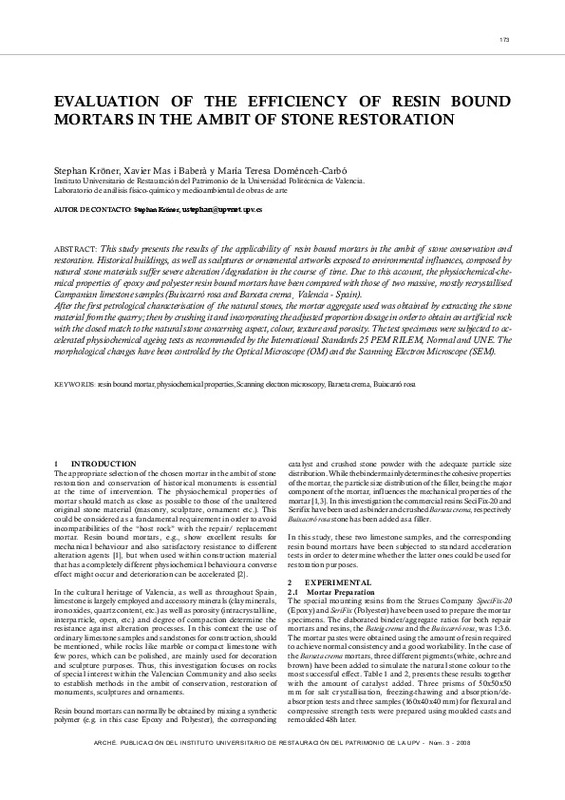|
Resumen:
|
This study presents the results of the applicability of resin bound mortars in the ambit of stone conservation and restoration. Historical buildings, as well as sculptures or ornamental artworks exposed to environmental ...[+]
This study presents the results of the applicability of resin bound mortars in the ambit of stone conservation and restoration. Historical buildings, as well as sculptures or ornamental artworks exposed to environmental influences, composed by natural stone materials suffer severe alteration/degradation in the course of time. Due to this account, the physiochemical-chemical
properties of epoxy and polyester resin bound mortars have been compared with those of two massive, mostly recrystallised Campanian limestone samples (Buixcarró rosa and Barxeta crema, Valencia - Spain). After the first petrological characterisation of the natural stones, the mortar aggregate used was obtained by extracting the stone material from the quarry; then by crushing it and incorporating the adjusted proportion dosage in order to obtain an artificial rock with the closed match to the natural stone concerning aspect, colour, texture and porosity. The test specimens were subjected to accelerated physiochemical ageing tests as recommended by the International Standards 25 PEM RILEM, Normal and UNE. The morphological changes have been controlled by the Optical Microscope (OM) and the Scanning Electron Microscope (SEM).
[-]
This study presents the results of the applicability of resin bound mortars in the ambit of stone conservation and restoration. Historical buildings, as well as sculptures or ornamental artworks exposed to environmental ...[+]
This study presents the results of the applicability of resin bound mortars in the ambit of stone conservation and restoration. Historical buildings, as well as sculptures or ornamental artworks exposed to environmental influences, composed by natural stone materials suffer severe alteration/degradation in the course of time. Due to this account, the physiochemical-chemical
properties of epoxy and polyester resin bound mortars have been compared with those of two massive, mostly recrystallised Campanian limestone samples (Buixcarró rosa and Barxeta crema Valencia - Spain). After the first petrological characterisation of the natural stones, the mortar aggregate used was obtained by extracting the stone material from the quarry; then by crushing it and incorporating the adjusted proportion dosage in order to obtain an artificial rock with the closed match to the natural stone concerning aspect, colour, texture and porosity. The test specimens were subjected to accelerated physiochemical ageing tests as recommended by the International Standards 25 PEM RILEM, Normal and UNE. The morphological changes have been controlled by the Optical Microscope (OM) and the Scanning Electron Microscope (SEM).
[-]
|







